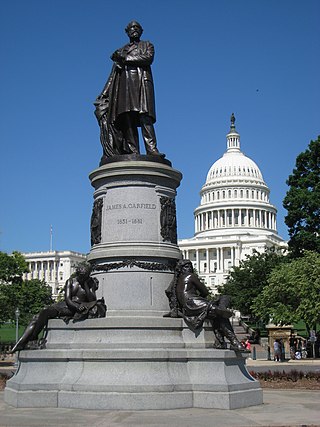
The James A. Garfield Monument stands on the grounds of the United States Capitol in Garfield Circle, a traffic circle at First Street and Maryland Avenue SW in Washington, D.C. It is a memorial to U.S. President James A. Garfield, who was elected in 1880 and assassinated in 1881 after serving only four months of his term. The perpetrator was an attorney and disgruntled office-seeker named Charles J. Guiteau. Garfield lived for several weeks after the shooting, but eventually succumbed to his injuries. The monument is part of a three-part sculptural group near the Capitol Reflecting Pool, including the Peace Monument and the Ulysses S. Grant Memorial in Union Square. The monument is also a contributing property to the National Mall and L'Enfant Plan, both of which are listed on the National Register of Historic Places and the District of Columbia Inventory of Historic Sites. The bronze statue rests on a granite pedestal that features three sculptures, each one representing a time period in Garfield's life.

Stanton Park, previously known as Stanton Square, is a national park in Washington D.C. It is located at the intersection of Maryland Avenue and Massachusetts Avenue in the Capitol Hill neighborhood of Northeast, Washington, D.C. It is bounded by 4th Street to the west and 6th Street to the east. North and south of the park are the respective westbound and eastbound lanes of C Street, NE.

The John Paul Jones Memorial, also known as Commodore John Paul Jones, is a monument in West Potomac Park, Washington, D.C. The memorial honors John Paul Jones, the United States' first naval war hero, and received the Congressional Gold Medal after the American Revolutionary War ended. Jones allegedly said "I have not yet begun to fight!" during the Battle of Flamborough Head.
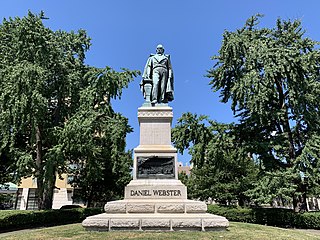
The Daniel Webster Memorial is a monument in Washington, D.C., honoring U.S. statesman and lawyer Daniel Webster. It is located near Webster's former house, beside Scott Circle, at the intersection of Massachusetts Avenue, N Street, and Rhode Island Avenue NW. The person who commissioned the memorial was Stilson Hutchins, founder of The Washington Post, who greatly admired Webster. Congress approved the memorial in 1898 and the dedication ceremony took place in January 1900. Amongst the attendees at the ceremony were President William McKinley and his cabinet, members of Congress, and Supreme Court justices.

The Luther Monument is a public artwork located in front of Luther Place Memorial Church in Washington, D.C., United States. The monument to Martin Luther, the theologian and Protestant Reformer, is a bronze, full-length portrait. It is a copy of the statue created by Ernst Friedrich August Rietschel as part of the 1868 Luther Monument in Worms, Germany. The version in Washington, D.C., inspired the installation of many other castings across the U.S. The statue is a contributing property to the Luther Place Memorial Church's listing on the National Register of Historic Places (NRHP) and District of Columbia Inventory of Historic Sites (DCIHS). It is also a contributing property to the Greater Fourteenth Street Historic District, which is also listed on the NRHP and DCIHS.

Edmund Burke is a bronze, full-length statue of British statesman, author, orator, political theorist, and philosopher Edmund Burke by British artist James Havard Thomas. The original statue is in Bristol, England, with a second cast in Washington, D.C. The statue in Washington, D.C., stands in Burke Park, at the intersection of 11th Street, L Street, and Massachusetts Avenue NW, on the southern border of the Shaw neighborhood. The statue was a gift from the Charles Wakefield, 1st Viscount Wakefield, on behalf of the Sulgrave Institution, an organization that wanted to celebrate United Kingdom–United States relations. One way the group did this was by exchanging statues and busts between the two countries.

Lieutenant General George Washington is an 1860 equestrian statue of George Washington, at Washington Circle, at the edge of the George Washington University's campus, in Washington, D.C. The statue was sculpted by Clark Mills, who also created the equestrian statue of Andrew Jackson in front of the White House. The traffic circle where the statue is located was one of the original city designs by Pierre Charles L'Enfant. The statue and surrounding park are in the Foggy Bottom neighborhood at the intersection of 23rd Street, New Hampshire Avenue, and Pennsylvania Avenue NW. The K Street NW underpass runs beneath the circle.
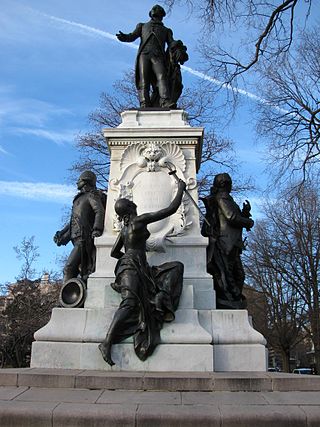
Major General Marquis Gilbert de Lafayette is a statue in the southeast corner of Lafayette Square, in Washington, D.C., near the intersection of Pennsylvania Avenue and Madison Place, across the street from the White House. The statue was erected in 1891 to honor Gilbert du Motier, Marquis de Lafayette, and his contributions in the American Revolutionary War. The square, originally part of the President's Park, was named in honor of the Marquis in 1824 during a visit he made to the U.S. The statuary was made by Alexandre Falguière and Antonin Mercié, and the architect who designed the marble pedestal was Paul Pujol. The monument comprises a bronze statue of the Marquis de Lafayette about 11 ft (3.4 m) high, standing on a French marble pedestal with four faces decorated with classical mouldings, accompanied by seven additional bronze statues, all larger than life size.

Brevet Lt. General Winfield Scott is an equestrian statue in Washington, D.C., that honors career military officer Winfield Scott. The monument stands in the center of Scott Circle, a traffic circle and small park at the convergence of 16th Street, Massachusetts Avenue and Rhode Island Avenue NW. The statue was sculpted by Henry Kirke Brown, whose best-known works include statues of George Washington in New York and Nathanael Greene in Washington, D.C. It was the first of many sculptures honoring Civil War generals that were installed in Washington, D.C.'s traffic circles and squares and was the second statue in the city to honor Scott.

Brigadier General Thaddeus Kościuszko is a bronze statue honoring Polish military figure and engineer Tadeusz Kościuszko. The sculpture was dedicated in 1910, the third of four statues in Lafayette Square, Washington, D.C., to honor foreign-born heroes of the American Revolutionary War. Born in the Polish–Lithuanian Commonwealth in 1746, Kościuszko later received education at a Jesuit school before attending the Corps of Cadets in Warsaw. He later traveled to France where he studied in military academy libraries and adopted views of human liberty during the Age of Enlightenment. He moved to the Thirteen Colonies in 1776, where the war with the Kingdom of Great Britain had already begun. Kościuszko served as an engineer in the Continental Army, earning the praise of his superiors, including General George Washington.

Major General Comte Jean de Rochambeau is a bronze statue honoring Jean-Baptiste Donatien de Vimeur, comte de Rochambeau, a French nobleman and general who played a major role in helping the Thirteen Colonies win independence during the American Revolutionary War. Rochambeau joined the French military as a teenager, participating in the War of Austrian Succession, after which he was promoted to colonel, and the Seven Years' War. During the war in America, Louis XVI asked Rochambeau to lead a force of 5,500 French soldiers to assist the fight against the Kingdom of Great Britain. He and George Washington later worked together in the successful siege of Yorktown. He led the Army of the North during the French Revolutionary Wars, but was arrested and almost executed during the Reign of Terror. His military rank was restored by Napoleon and Rochambeau died a few years later in 1807.

Major General Friedrich Wilhelm von Steuben is a bronze statue of Friedrich Wilhelm von Steuben, a Prussian soldier who assisted the Thirteen Colonies during the American Revolutionary War. Steuben had fought in previous wars, earning promotions until he assisted in the courts of Frederick the Great and later Josef Friedrich Wilhelm, Prince of Hohenzollern-Hechingen. After meeting with Benjamin Franklin, and fearing for his safety in Europe after alleged homosexual behavior, Steuben and his associates arrived to help the Continental Army.
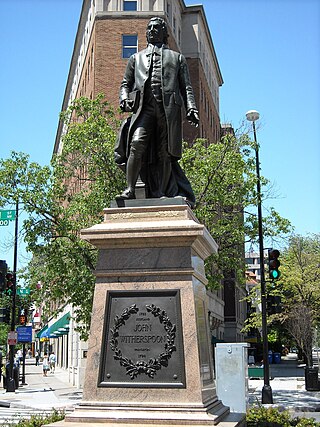
Doctor John Witherspoon is a bronze sculpture and granite pedestal which depicts John Witherspoon, a Presbyterian minister, member of Congress, and signer of the Declaration of Independence. Born in Scotland, Witherspoon immigrated to the U.S. in the 1760s and later became president of the College of New Jersey. He strongly supported the Thirteen Colonies in their fight to obtain freedom from the United Kingdom of Great Britain and Ireland.

The statue of John Barry commemorates the "Father of the United States Navy", Commodore John Barry (1745-1806). Barry was an Irish-born sailor who joined the American colonists in fighting for independence from the Kingdom of Great Britain. Barry became the first commission by the Second Continental Congress. He captained several ships during the American Revolutionary War, and not only fought in the Continental Navy, but also the Continental Army. He was the first American to capture an enemy ship and was promoted to commodore by President George Washington in 1794. Barry's last ship, the United States, fought in the Quasi-War. He retired in 1801, but remained head of the United States Navy until his death in 1806.

The outdoor statue of Benjamin Franklin in Washington, D.C., is located near the intersection of 12th Street and Pennsylvania Avenue NW, in front of the Old Post Office. The statue was a gift from Stilson Hutchins, founder of The Washington Post, who wanted to display his and the newspaper's stature in the city. The designer, Ernst Plassmann, and sculptor, Jacques Jouvenal, were both German-American artists. The architect of the memorial was J. F. Manning.

General Casimir Pulaski is a bronze equestrian statue of Casimir Pulaski, a military man born in the Polish–Lithuanian Commonwealth. He joined the military at a young age, fighting for removal of the king, who was backed by Russia. After his side lost the war, he fled to Paris, where he met Benjamin Franklin. Impressed by Pulaski, Franklin wrote a letter of recommendation to George Washington, suggesting he would be a helpful soldier during the American Revolutionary War. After arriving in the U.S., Pulaski eventually was promoted to Brigadier General and commanded a cavalry unit, the Pulaski's Legion. He died in 1779 due to injuries sustained in battle.

American Revolution Statuary is a group of fourteen statues in Washington, D.C., that honor men whose actions assisted the Thirteen Colonies in their fight against the Kingdom of Great Britain in the American Revolutionary War. They are spread throughout the city, except for the four statues in Lafayette Square, across from the White House, that honor some of the foreign heroes from the war. Some of the statues are located in prominent places, while others are in small parks or stand alone in front of buildings. All of the statues are owned and maintained by the National Park Service, an agency of the United States Department of the Interior. The statuary was collectively listed on the National Register of Historic Places (NRHP) in 1978 and the District of Columbia Inventory of Historic Sites the following year. In addition, most are also contributing properties to historic districts listed on the NRHP.
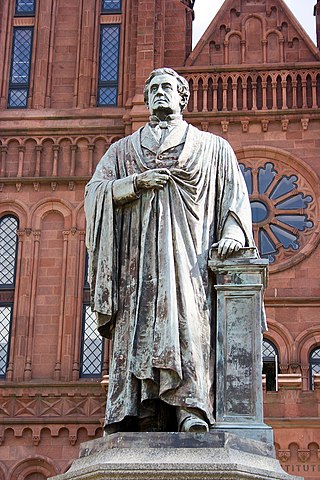
Professor Joseph Henry, also known as the Joseph Henry Memorial, is an outdoor bronze sculpture depicting scientist Joseph Henry, the first president of the Smithsonian Institution. The statue stands in front of the Smithsonian Institution Building in Washington, D.C., facing the National Mall. It was sculpted by artist William Wetmore Story, and dedicated in 1883, a few years after Henry's death. The bronze statue and granite base were unveiled in front of thousands of onlookers and invited guests. Speeches at the dedication included one from Chief Justice of the Supreme Court Morrison Waite, and the president of Yale College, Noah Porter.

Nathaniel Greene is an 1870 marble statue of Nathanael Greene by Henry Kirke Brown, installed in the United States Capitol, in Washington, D.C., as part of the National Statuary Hall Collection. It is one of two statues donated by the state of Rhode Island. The statue portrays Greene dressed in the uniform of a Revolutionary War general, holding a sword in his left hand.
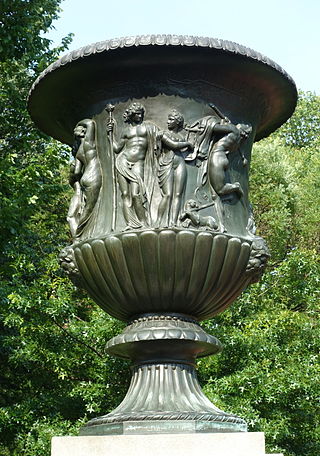
The Navy Yard Urns are two decorative bronze urns located in Lafayette Square, a small park across the street from the White House, in Washington, D.C. They were originally planned to be installed in the 1850s, but due to the Civil War and other events, they were not erected until 1872. Secretary of the Navy George M. Robeson had ordered the urns be made at the Washington Navy Yard using melted cannons from the Civil War.





















